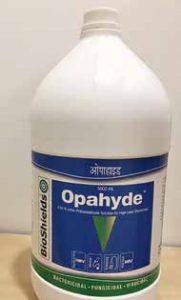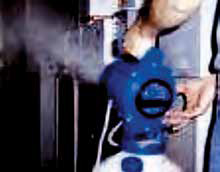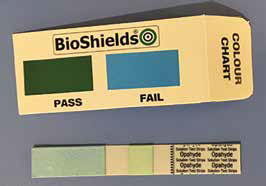
Dr. Indrish Bhatia
Consultant, Medanta-the Medicity
Gurugram
A large number of chemicals have been used as disinfectants and sterilants. These are mostly germicidal agents though a lot of them have a bacteriostatic effect in general use. A brief not on their mode of action and recommended use is under.
Alcohols
Seventy percent isopropyl alcohol and 70% ethyl alcohol can be rapidly germicidal against bacteria, fungi, and viruses by denaturating proteins. However these disinfectants do not destroy bacterial spores and may not completely eliminate certain viruses. Both 70% isopropyl and 70% ethyl alcohol can inactivate human immunodeficiency virus (HIV), and 70% isopropyl alcohol additionally kills Acanthamoeba cysts effectively. In view of their lack of sporicidal activity, they cannot be used for sterilizing medical and surgical materials. Additionally they are unable to effectively penetrate protein-rich materials and this hampers their effectiveness. In fact, they are no longer considered to be high-level disinfectants and are not recommended for semicritical instruments.

Chlorine and Chlorine Compounds
Dilute sodium hypochlorite (Dilute bleach) is a universal disinfectant. It is generally used in a 1:10 or sometimes a 1:20 concentrations for disinfection. It is effective against viruses (including HIV), bacteria, bacterial spores, mycoplasma, mycobacterium tuberculosis, and fungi.1 Bleach is fast and effective, has a broad spectrum antimicrobial activity, does not leave any toxic residue of the equipment and is not affected by hardness of water. This makes it a popular disinfectant. It oxidizes cell membranes and denatures proteins, which leads to loss of structure and cell lysis
Hydrogen Peroxide
Hydrogen peroxide 3% is an effective germicidal which acts against Acanthamoeba cysts, bacteria, Yeasts, fungi, most viruses, and some spores. Some anaerobic and facultative anaerobes may be resistant to hydrogen peroxide in low concentrations, however 10% hydrogen peroxide deactivates most of them. It releases destructive hydroxyl free radicals that oxidize membrane lipids, DNA, and other cell components. It is extremely irritating to eyes and has a corrosive nature for metallic instruments. It does not require any activation and disposal is safe. 3% hydrogen peroxide has been used to dieinfect applanation prisms.
Organomercury agents
Thiomersal (INN), or thimerosal (USP), is an organomercury compound sold uder the brand Merthiolate. This compound is a well established antiseptic and antifungal agent. It has been used for disinfection of certain ophthalmic equipments and products but is now losing popularity over better and less toxic agents. It is very toxic by inhalation, ingestion, and in contact with skin.
Aldehydes
Glutaraldehdyde
Activated Glutaraldehyde Solution (Cidex) is a high level disinfectant which is very popular in medical practice. Cidex contains 2.4% glutaraldehyde and has many benefits as a sterilant. It is fast acting and achieves results in 20 minutes at 20°C (room temperature). It is effective against bacteria, mycobacteria, viruses and fungi. It also possesses some sporicidal activity with longer exposure times. It is compatible with a large number of instruments
and devices and has been used in ophthalmology for disinfection OT Sterilization of probes, forceps and implants. It
has also found use in the operation theatre for quick sterilization of some instruments in special situations. The biocidal activity of glutaraldehyde is a consequence of its alkylation of sulfydryl, hydroxyl, carboxyl and amino groups, which alters RNA, DNA and protein synthesis within microorganisms The non-carcinogenic, non corrosive nature and low cost make it a very popular agent. One disadvantage is the irritation it causes on the skin and mucous membranes and slow anti-mycobacterial activity.
Ortho-phthalaldehyde (OPA)
Ortho-phthalaldehyde 0.55% (OPA) is a high-level disinfectant with shorter immersion time of 12 minutes at 20°C and 5 minutes at 25°C. It is a reusable product with a maximum reuse life of 14 days. It is marketed as Cidex OPA. The properties and mechanism of action is similar to glutaraldehyde as described above. For OPA,use certain processes have to be followed for use. The date of opening of concentrate should be labelled on the primary container which may be used upto 75 days from opening. The container in which the OPA is diluted should be labelled with date of filling and discard. These can be upto 14 days apart. A cidex strip test should be done every day or before every use whichever is lesser and result logged into a log book. The strips can be used upto 90 days after opening. Equipment should be kept in OPA for atleast 5 minutes for proper disinfection. The solution should be discarded in special containers for disposal.
Suggested Reading
Rutala, W. A., & Weber, D. J. (2013). Disinfection and sterilization: An overview. American Journal of Infection
Control, 41(5), S2-5.
OT Sterilization

It is of paramount importance that the OT being used for intraocular surgeries be a standalone ophthalmology OT. Other specialty surgeries, or for that matter, infected extraocular surgeries, like a dacryocystorhinostomy (DCR), should not be done in that OT. The OT layout should include an outer zone for housing the reception area, which should be separated from the preoperative area by a clean changing room. The patient scheduled for surgery walks to the reception area where his OPD papers and relevant investigations are checked. After confirming that the patient is fit for surgery on that day, (s)he is sent to the changing room. After changing into OT clothes, the patient walks into the preoperative area, where further preparations for the procedure, like dilatation of the eye, xylocaine sensitivity test etc. are done. It is in this area that the patient awaits his turn for surgery. The preoperative area should then lead to the aseptic zone that houses the scrubbing/gowning area and the operation room. The operating room should have a minimum area of 180 sq ft. In addition, there should be a separate room for autoclaving sterilizing instruments. Proper disposal techniques and zones for discarding used equipment should be in place.
Fumigation at periodic intervals is essential to maintain sterility of the OT. If an OT is being used for the first time, it should be fumigated thrice prior to starting any operations. For a running OT, single fumigation is enough. Fumigation involves spread of formalin as aerosol spray in the OT area (30ml of 40% Formalin dissolved in 90 ml of clean water for every 1000 cft of OT space), to be left for 6 hours. This is to be followed by carbolization of the OT with 2% carbolic acid. If fumigator is not available, formalin dissolved in potassium permanganate (5 ml of 40% Formalin in 10 gms Potassium permanganate for every 1000 cft of OT space) is to be left in the OT for 24 hours. Formalin fumigation should be done at weekly intervals.
Another method of chemical disinfection of the OT involves the use of Aldekol, which is a mixture of 6% Formaldehyde, 6% Glutaraldehyde and 5% Benzalkonium chloride. For 4000 cft of OT space, 325 aldekol in 350 ml of water is sprayed for 30 minutes, and then the OT is closed for 2 hrs. The AC is then switched on, and the OT is ready for use in another hour.
Air conditioner maintenance is another aspect of OT sterilization that should not be forgotten. Uncleansed AC vents and ducts can harbor infectious organisms that can compromise the sterility of an otherwise meticulously maintained OT. AC filters need to be cleaned every week. Monthly maintenance and cleaning of the AC complex needs to be carried out.
All personnel involved in the OT should undergo periodic training on OT sterilization through seminars and videos, and their knowledge of the same should be periodically assessed.
